Nowadays you won’t surprise anyone with a delicious unusual cake, because the service market is filled with offers from talented confectioners working at home. Store shelves are filled with factory-made sweet products of any price category. How to surprise your beloved family and friends? And here cake mastic comes to the rescue.
Confectioners often love mastic for its plasticity, pleasant sugary taste, bright colors, and ability to harden. Thanks to her, ordinary cakes become a true work of art.
It is sold in any specialized store, where you can also purchase or order ready-made figurines from it, but it will cost a lot. It will be much more “budgetary” to make it yourself, especially since there are several recipes for its preparation, and you can choose your own.
It may seem quite simple to do it at home, but, as a rule, problems may arise at first. The main thing is not to despair, but to try until you get a sweet mass with the consistency of soft plasticine. You may need to use a different recipe.
Homemade mastic can easily be used to make the intended figures; it should be easy to roll out with a rolling pin without tearing. This is necessary for covering a cake or pastry. Dyes can be added either directly during the mixing process or added colors in finished form.
There are several ways to make mastic.
From marshmallows
This is one of the most simple recipes homemade mastic for cake. It comes out unusually pleasant, soft, and flexible. This sugar material will definitely make real confectionery masterpieces.
Marshmallows are Western sweets. They are an airy soufflé. Not to be confused with our favorite marshmallow. Often on bags of such candies it is written “marshmallow”.
![]()
Russian manufacturers replace the name with “soufflé”. When choosing this product, it is better to choose white candies, as they can easily be colored with dye.
Ingredients:
- marshmallow – 100g. (one package of soufflé);
- water or lemon juice – 1 tbsp;
- powdered sugar – 1-1.5 cups.
The amount of ingredients, of course, can be increased if you need a lot of mastic for decoration.
Pay attention to the quality of the powdered sugar; it must be thoroughly ground. Only in this case will you get a uniform mass, ideal for culinary creativity. This rule applies to all recipes.
Preparation:
- Place the marshmallows in a deep microwave-safe bowl. Add lemon juice or water to the fluffy candies;
- Next, place the container in the microwave for 10-20 seconds. The soufflé should melt and increase in volume. The microwave can be replaced with a water bath;
- Remove the heated and swollen marshmallows. If necessary, add food coloring to the mixture and mix;
- Now comes the turn of the sifted powdered sugar. It is better to pour it into a bowl in small parts and knead with a spatula until the familiar dough is formed;
- Sprinkle the table with powdered sugar like flour. Take the mastic blank out of the cup and knead it by hand until it stops being sticky;
- Immediately pack fresh mastic tightly in cling film and place it in the refrigerator for 30-40 minutes.
After this, you can safely start creating with a kind of sugar plasticine or use it to cover a cake.
Lemon juice or water is sometimes replaced with butter, and some even mix these products. You can try this option too.
From condensed milk
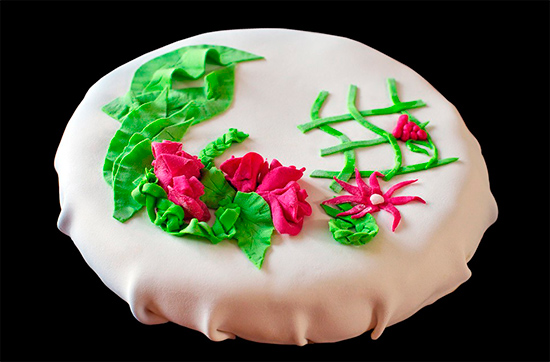
This method of preparing sweet culinary mass can be called “for the lazy.”
Ingredients:
- powdered milk - 1.5 tbsp;
- condensed milk - 1 can;
- powdered sugar - 1 tbsp.
Preparation:
Combine dry milk and condensed milk in a cup until a mass appears that looks like soft plasticine in jars. That's all. You will get the most delicate, non-sugary homemade mastic with a pleasant milky taste. True, it cannot boast of a pure white color, and the added dyes will be distorted in shades. Parents of children will appreciate milk mastic.
If this type of cake design does not seem very sweet, you can add more powdered sugar.
Chocolate
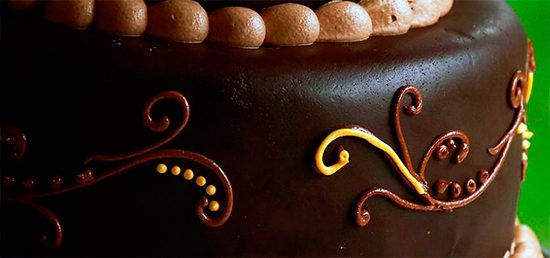
Chocolate fans will certainly appreciate this mastic. Its peculiarity is that decorations made from it do not harden entirely in the air, remaining soft, they can even be eaten separately from the cake. And the magical chocolate taste and shade will definitely capture the hearts and mouths of many.
Ingredients:
- marshmallow - 90 g;
- dark chocolate -100 g;
- butter - 0.5-1 tbsp. l.;
- cream (30%) - 40 ml;
- powdered sugar - 100-120 g;
- cognac - 1-2 tbsp. l.
- Place the chocolate pieces in a saucepan and melt it in a water bath;
- Add soufflé there. Constantly stir the entire contents of the saucepan;
- As soon as half has melted, pour cognac, cream and butter into the melted chocolate. Do not forget to stir all the time until you see a thick paste without grains;
- Remove the container from the heat and, continuing to work with a spoon, pour powdered sugar into the contents. Next, follow the analogy of preparing marshmallow mastic. The result should be a fatty plastic mass that does not stick to your hands at all.
From gelatin
Also a very simple recipe.
Required components:
- gelatin-2 tsp;
- powdered sugar-0.5 kg;
- water-50 ml.
Preparation:
- Place gelatin in a cup, add water and dissolve in a water bath;
- Carefully pour the cooled gelatin into the powder. As in previous recipes, you need to mix the mass until it becomes clay.
From marshmallows
This method of preparation is completely identical to the version with marshmallows. It is important not to confuse the soufflé with a denser marshmallow. To prepare it, you need to cut it into large pieces. Many people do not notice the difference in taste and quality of these two masses. Only marshmallows, as a necessary component, can be bought in every store, unlike marshmallows. And whoever knows how much a soufflé costs will immediately understand which mastic will be more profitable for the hostess’s wallet.
Sugar
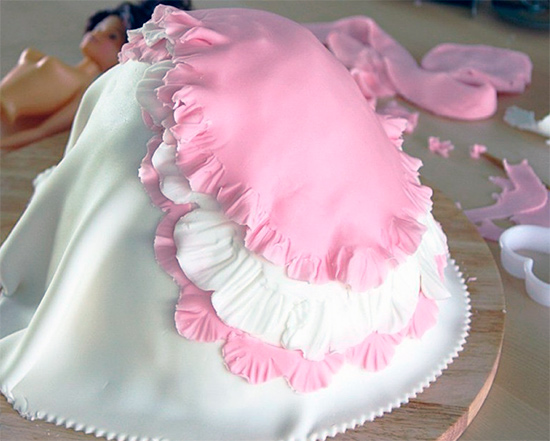
It is believed that this cooking option is very simple, but many housewives will argue with this. An impressive list of required ingredients confirms this:
- sour cream or milk - 0.5 cups;
- gelatin – 3 tbsp;
- caramel molasses - 1 cup;
- oil – 3 tbsp;
- glycerin-3 tbsp;
- vanilla – 2 tbsp;
- sugar – 1.5. kg.
Preparation:
- Mix gelatin with sour cream. After the gelatin thickens, place the mixture in the microwave and heat until it completely melts;
- Next, you need to put together caramel, glycerin, butter, vanilla, salt and pour this mixture into gelatin;
- Heat the resulting mass in the microwave for two minutes;
- Take about 1 kg. sugar and add the cooled mixture to it. Gradually add all the sugar to the mixture and mix with a mixer;
- Next, use the familiar method to bring it to the desired consistency. Then wrap it in cling film and put it in the refrigerator for 6 hours.
This recipe is not only the most labor-intensive, but also not financially profitable. Fans of experiments can try to bring it to life.
Secrets of use
In order for the cake mastic to perform its function 100% and give the baked goods an interesting, beautiful, memorable look, it is worth remembering a few rules when using it:
- Any mastic will melt from a wet base, so before covering the cake, “prime” it, for example, with butter cream;
- When exposed to air, it hardens, so you can either dry the treasured figures, or, conversely, cover them;
- To give it color at the creation stage, natural dyes are suitable: cocoa powder, beet and carrot juices, spinach;
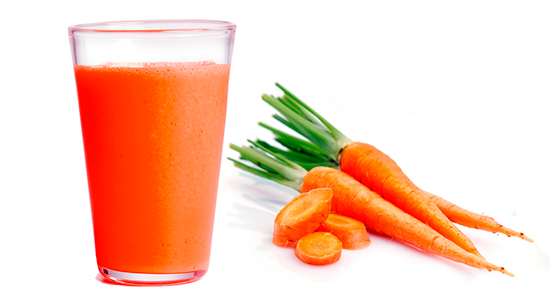
- If the mastic is difficult to roll, the sugar mass can be safely heated in the microwave;
- Before serving, the cake decorated with mastic can be lightly moistened with water using a silicone brush. Then its surface will acquire a pleasant, slightly glossy shine;
- Homemade cake mastic keeps well in the freezer for about 2 months;
- Dry mastic figurines can be used several times if you put them in a dry, closed container;
- To ensure that the parts of the product stick together well, it is better to moisten the attachment points with a drop of water.
Homemade cake mastic is a simple and budget-friendly option for creating a festive atmosphere even on an ordinary day.
Useful information?
Secrets of preparing and using mastic for cakes
5 (100%) 3Fondant decorations can transform a simple cake into a work of art. Sometimes decorations are so beautiful that you even feel sorry for eating them!
Mastic is used for other products. You can cover the finished cake with it; thanks to the mastic, the surface of the cake will have soft and varied shapes.
Fondant decorations can transform a simple cake into a work of art. You can make all kinds of decorations from mastic: leaves, flowers, flower compositions, various figures that... Sometimes decorations are so beautiful that you even feel sorry for eating them!
At first glance, mastic is easy to prepare, but it may not work out the first time. Therefore, you need to be patient and practice as often as possible, then you will learn to “feel” it. The mass should be plastic, like plasticine, but not stick to your hands. To begin with, it is better to experiment with a small amount of mastic.
In order to make various products from mastic, you can use stencils or special cuttings.
How to prepare mastic
Mastic is prepared from powdered sugar with the addition of water, gelatin and lemon juice. Glycerin and oil are also added, this is done so that the mastic does not dry so quickly. Knead the sugar mixture for 15 minutes.
It is better to knead the finished mastic on a table that has been previously sprinkled with powdered sugar; you can also use starch. This must be done to prevent the mastic from sticking to the table and hands while working with it.
Mastic can be tinted with beet juice, spinach juice, carrot juice, juice of various berries, or dyes sold in the store.
The finished mastic must be packaged in cling film to prevent it from drying out.
You need to decorate cakes with mastic after the cream has hardened. It is better if the cake is covered with marzipan mass or the surface of the cake consists of dry sponge cake.
How to cover a cake with fondant
In order to cover the cake with mastic, you need to place it on a turntable, this will make it more convenient to work with it. Sprinkle the surface of the table with powdered sugar, then roll out the mastic to 5 mm thick on the table. The rolled out mastic should be wider than the cake.
Using a rolling pin, place the fondant onto the cake. Sprinkle your hands with starch and smooth the mastic first over the surface of the cake so that it fits tightly to it, then on the sides. Trim off excess fondant along the base of the cake with a knife. From the leftovers you can make a figurine or other decorations - leaves or a flower.
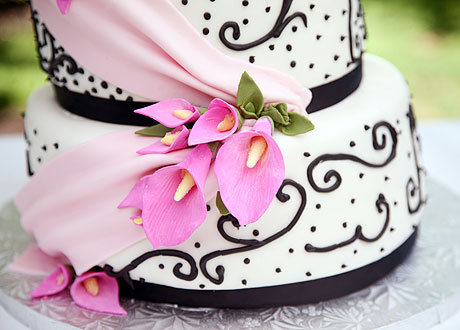
If further decoration of the cake is not provided, then the mastic can be wrapped in cling film and stored in the refrigerator, but for no more than 2 weeks.
3 mastic recipes for cakes
Simple mastic with gelatin
Ingredients:
- Powdered sugar - 450 +/-50 g,
- Gelatin (powder) - 2 teaspoons,
- Water - 50 ml.
Preparation:
Pour gelatin into a bowl of cold water, stir and leave to swell. Dissolve (editor's note - dissolve) it in a water bath and cool.
Sift the powdered sugar, pour in the gelatin and knead until smooth. Roll it into a ball and put it in a plastic bag. If the mixture becomes sticky during cooking, add powdered sugar. If you succeed good mastic, and there is still powder on the table, then continue kneading, removing excess powder.
Mastic with egg white
Ingredients:
- Powdered sugar – 450-500 g,
- Glucose syrup - 2 tbsp. spoons.
- Egg white - 1 pc.
Preparation:
Combine egg white and glucose in a bowl and stir. Add powdered sugar (450 g), sifted in advance, and knead until smooth. Roll it into a ball and put it in a plastic bag, leave it in it for 2 hours. Then knead again. If the mixture turns out sticky, add powdered sugar. If you have already made good mastic, but there is still powder on the table, then continue kneading, removing excess powder.
Mastic with vegetable oil
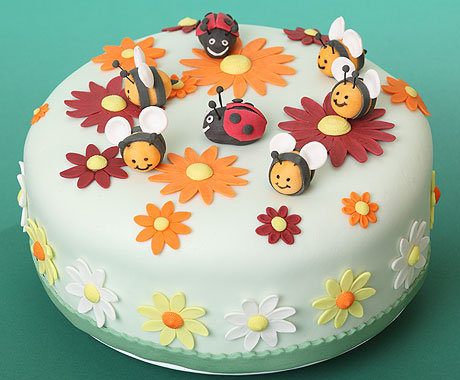 How to make mastic for cakes
How to make mastic for cakes Ingredients:
- Powdered sugar (sifted) - 450 +/- 50 g,
- Powdered gelatin - 1 tbsp. spoon,
- Vegetable oil - 2 tbsp. spoons,
- Chicken protein - 1 pc.,
- cold - 30 ml,
- Liquid glucose - 1 tbsp. spoon.
Preparation:
Pour the gelatin into a bowl of cold water, stir and leave to swell, then dissolve it in a water bath and cool. Add glucose and vegetable oil to it, mix. Add the egg white, mix again and combine with powdered sugar. Stir the mixture with a spatula until a well-formed mass forms.
Place the resulting mass on the table, sprinkled with powdered sugar, and knead until smooth. Roll it into a ball and put it in a plastic bag, leave it in it for 1-2 hours. Then knead again and start rolling or sculpting.
If you make small figures or other products from mastic, then keep the rest of the mass in a plastic bag.
Tatiana CHEKRYGINA
Method for making marshmallow mastic at home:
- Take a deep glass bowl and place marshmallows in it. Microwave safe dishes can be used.
- Add lemon juice and butter.
- Place in the microwave for a few seconds. The marshmallow should begin to melt, but should not be allowed to completely dissolve or boil. As a rule, it takes 25–30 seconds to achieve the desired consistency, but due to different oven power, this process may take longer or faster.
- Remove and stir until smooth.
- Mix starch and powdered sugar.
- Gradually add powder and starch into the mixture, mixing thoroughly each time.
- When the mixture becomes thick and pliable, stops sticking to your hands and begins to shine, wrap it in cling film and place it in the refrigerator for a day.
Advice! When making mastic, always use store-bought powdered sugar. It must be very fine, which cannot be achieved at home. If there are grains of sugar in the powder, the mass will begin to tear.
How to color mastic for making figurines
Before sculpting, you should paint the mastic in the desired colors. To do this, use natural gel dyes. They are very economical, thick and concentrated, making it possible to obtain both bright, saturated colors and delicate warm shades.
To color fondant, separate a small ball of material, make a well in the center and add a little food coloring. Then stir vigorously until the color is uniform. After coloring, each piece must be wrapped in cling film to avoid drying.
You can paint a finished figure with a brush, but in this case You need experience and good artistic abilities. It is important not to paint on different parts of the figure and to be careful.
Making figurines from mastic
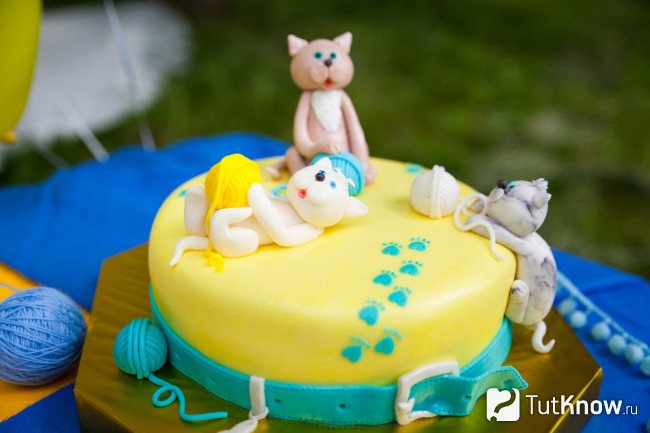
The basic design principle for the figure itself is quite simple:
- If you plan to transport the finished product, it is recommended to make a wire frame that will reliably secure the position and individual parts of the mastic figurine. The frame is also made in the case of a strong inclination of the figure.
- The face of a cartoon character or person can be made using a special mold, or using ordinary dolls with a relief profile.
- Various parts, such as the head and body, are connected using toothpicks or skewer.
- Small details, such as fingers, fringe on clothes, etc., are cut out with a knife or an artistic cutter.
- Patterns on the surface are drawn with a toothpick.
- Details such as eyes, lips, eyelashes, eyebrows, small fragments of clothing are colored with edible markers.
- To add shine to elements or give a natural look, use kandurin. It is diluted in vodka and applied to the figurine with a brush.
Important! During the modeling process, do not remove the main mass from the cling film. Having separated the desired piece from it, immediately wrap the edges of the film so that the mastic does not harden.
How to make flowers from mastic
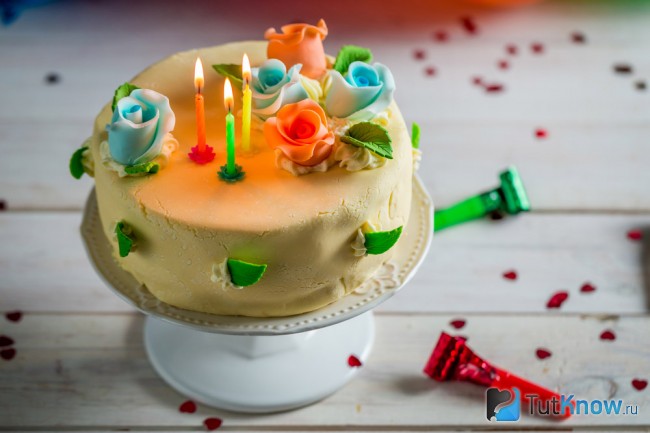
Flowers are the most popular, spectacular and traditional decoration for cakes. Mastic for creating flowers is particularly flexible, since it is rolled out in a very thin layer that should not tear.
Milk mastic recipe for flowers
To create simple compositions You can use a milk recipe:
- Mix sifted powdered sugar, dry milk and condensed milk in equal proportions. Knead until you obtain a homogeneous, thick mass.
- Divide the mixture into several parts and color with food coloring.
- Wrap each part in cling film and place in the refrigerator for a day.
Marshmallow flower mastic recipe
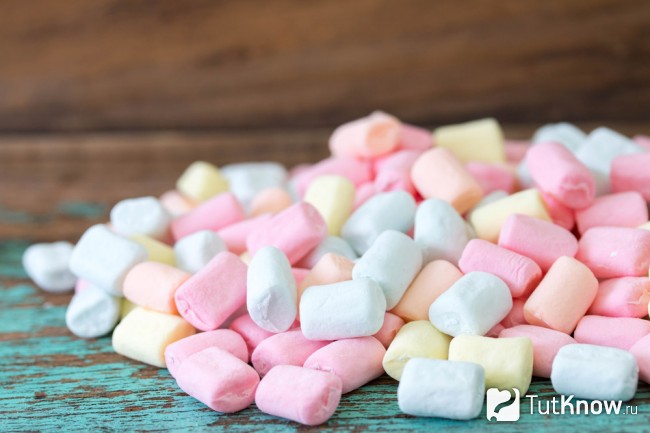
Ingredients:
- Egg white - 1 pc.
- Tragant - 2 teaspoons;
- Sifted powdered sugar - 250 grams.
Method for preparing marshmallow flower mastic for cake:
- Mix the protein, tragacanth and powder until a homogeneous, plastic mass.
- Wrap in cling film and leave for 4 hours.
- Add marshmallow mastic in a ratio of 1/3 to the previously prepared mass, mix thoroughly, wrap in film and leave in the refrigerator for a day.
Advice! To ensure that the mastic rolls out well and does not stick to the equipment, wrap the cutting board with cling film, sprinkle your hands and rolling pin with powdered sugar or starch.
How to form flowers from mastic
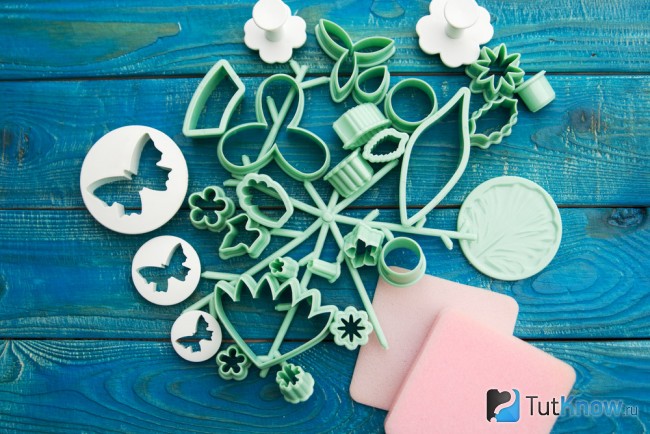
To form beautiful buds you will need: a mastic ball, foam rubber, foil, molds for cutting out flowers and petals, silicone viners, a toothpick.
An example of making a rose from mastic:
- Prepare the core for the flower - form an elongated circle in the shape of a drop and leave to dry for 2 hours.
- Roll out mastic pancakes in a thin layer, cut out a flower with a mold. Use a ball along the edges of the leaves to give them a natural, curved shape.
- Place the core on one edge of the toothpick.
- Place the cut out flower on a foam stand and pierce the center with a toothpick so that the core falls onto the petals.
- Fold the petals onto the core in the following sequence: 1, 3, 5, 2, 4. This will make the rose look more natural. Leave the workpiece for 10 minutes.
- Make the next layers three-leafed, i.e. remove the 2nd and 4th petals. The procedure for applying to the workpiece is the same as in the previous paragraph.
- Repeat this manipulation with the remaining layers until you achieve the desired thickness of the bud.
- The flower is dried with the head down.
Special cuttings will help you achieve the desired shape of the petals and leaves; you can make veins with a weiner or a toothpick. You can buy special confectionery equipment that includes everything necessary tools to give shape and pattern.
If you don’t have time for complex manipulations, use a 2D mold. Mastic is placed in the mold different colors, placed in the freezer for 5 minutes, then the finished flower is carefully removed from the mold.
Dry the fondant decorations well at room temperature and attach them to the cake just before serving. If you secure the flowers in advance and put them in the refrigerator, they will become saturated with moisture and fall off.
DIY pastilage
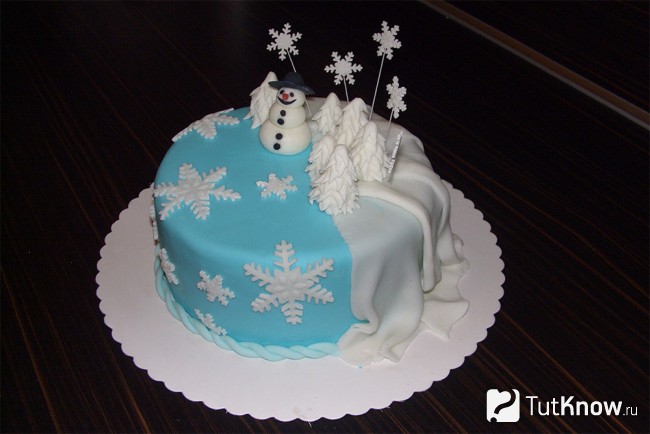
A recipe for mastic with gelatin or pastillage is often used to create complex flowers or figures with miniature elements for decorating a cake. This mass retains its given shape well, is very plastic and hardens quickly. At the same time, gelatin mastic is quite cheap financially, unlike other types.
Making pastillage is not easy. To ensure that the mass has the desired consistency, does not tear when rolling and does not crumble, it is necessary to strictly follow the technology for working with gelatin.
Ingredients for pastillage:
- Gelatin - 25 g;
- Sugar - 2 cups;
- Powdered sugar - 1.2 kg;
- Starch - 300 g;
- Water - 1 glass;
- Maple or corn syrup - 170 g;
- Salt - on the tip of a teaspoon.
- Pour gelatin into 0.5 cups of cold water and leave for several hours.
- Put the gelatin on the fire and hold until the lumps are completely dissolved. Do not bring to a boil, otherwise the product will lose its properties. Strain.
- Mix sugar, syrup, salt and 0.5 cups of water. Bring to a boil, stirring constantly with a whisk. Reduce heat and leave to simmer for 8 minutes. Remove from heat.
- Place the mixer into the hot mixture and begin whisking, slowly adding the gelatin.
- Beat at maximum speed until the total mass increases significantly. The mixture becomes airy, fluffy and white, increasing almost 3 times its original volume. The desired consistency is usually achieved in 10–13 minutes.
- Replace the beater attachments with spiral beaters and continue mixing, gradually adding powdered sugar.
- As a result, you will get a thick snow-white mastic, which you need to cover on top with cling film and leave for a day at room temperature.
- The next day, place the mastic from the bowl onto a cutting board thickly strewn with starch. Knead the mixture, wrap it in film and put it in the refrigerator for a day.
Be sure to sift the flour and strain the gelatin through a fine sieve before using. Undissolved lumps make the mass less elastic, it begins to tear when stretched, and loses its even, homogeneous structure.
How to make mastic for covering a cake
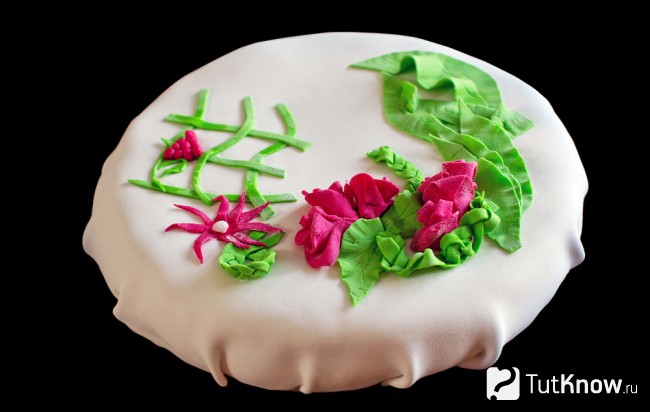
The cake benefits in beauty and taste when completely covered with a delicate and thick paste. Covering the surface of the cakes will not be special labor, if you choose the right mastic recipe.
Sugar mastic recipe
Sugar mastic is suitable for decorating a cake with a single-color filling. It has a very soft texture, rolls out well in a thin layer and is evenly distributed, fitting the cakes. You can also use milk or marshmallow paste.
Ingredients:
- Gelatin - 2 tbsp;
- Powdered sugar - 3 cups;
- Lemon juice - 1 tsp.
- Place instant gelatin in cold water for 40 minutes. Place on the fire and melt until the lumps disappear completely.
- Add powdered sugar and mix thoroughly.
- Add dye if you plan to get a certain color of mastic, mix until you get a uniform tone.
- To make the mixture less cloying, add lemon juice.
- After kneading the paste, wrap it in film and place it in the refrigerator for a day.
Covering the cake is quite simple. The main condition is to level the sides and surface of the product using marzipan paste, ganache, butter cream or condensed milk.
The cake should not be too soaked and its surface should not be wet. Place it in the refrigerator after leveling so that the cream becomes firm.
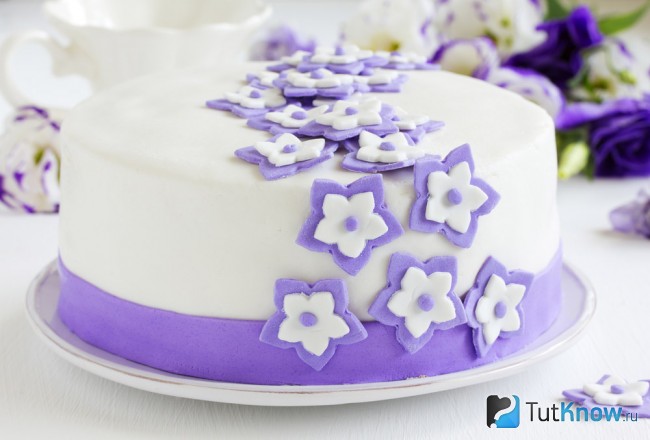
The cake is covered with mastic as follows:
- Place the mastic on a cutting board covered with film, knead it and roll it out with a rolling pin so that the surface is no thinner than 3-4 mm.
- Measure the cake based on its diameter and height. The rolled out mass should cover the entire cake, leaving a margin of 10–15 cm at the edges. This diameter will allow the mastic to lie flat and be evenly distributed over the entire surface.
- Carefully lift the fondant and cover the cake, carefully leveling it over the top layer and sides.
- Trim off the excess pasta at the base with a pizza cutter.
- Level with a spatula.
- If the canvas is torn, you can smooth out the hole with a brush dipped in water.
Mastic, prepared independently, is an original and tasty decoration for home baking. You can completely envelop the cake with it, make beautiful patterns, flowers or personal inscriptions, sculpt figures or create a three-dimensional composition on the product that will delight the craftswoman and surprise the guests.
Other photos:
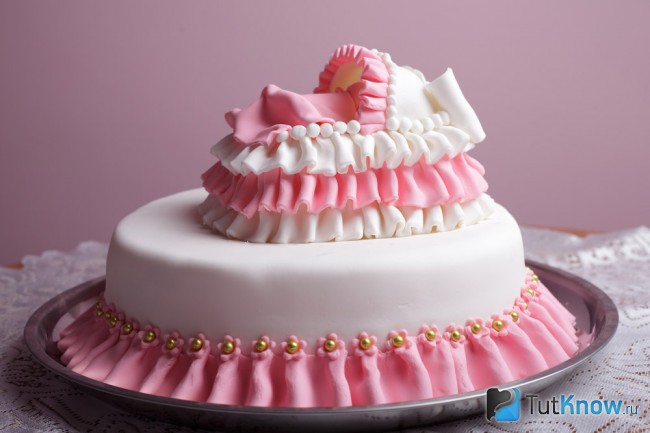
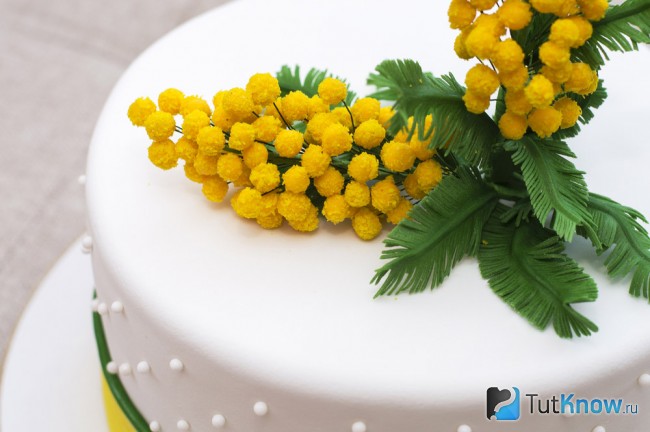
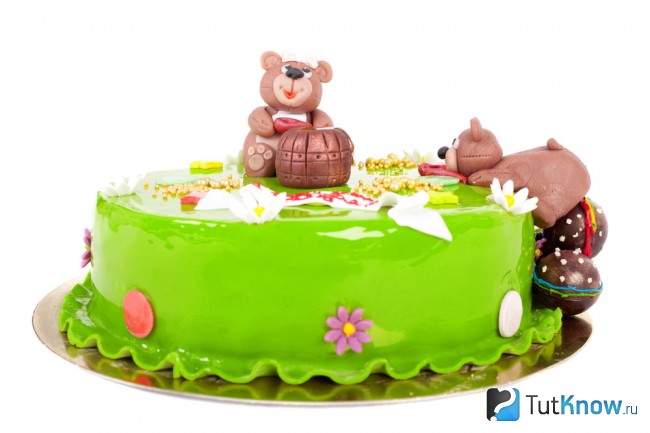
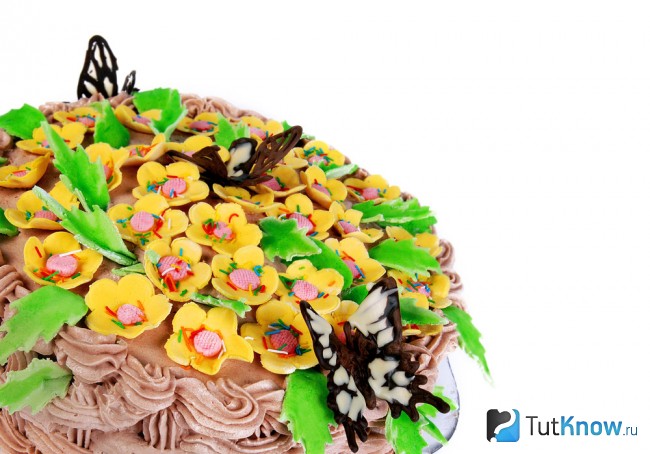
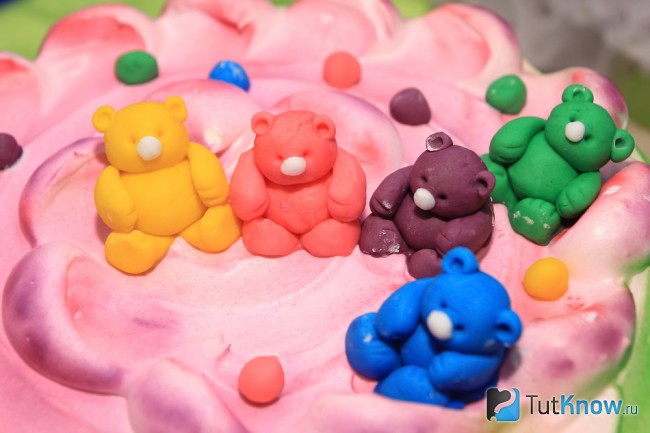

There are many cake recipes, some of which are passed down from generation to generation.Culinary experts do not get hung up on monotony and are always in search of something new.
Mastic- This interesting option decorating a cake that will surprise everyone.
A special paste is designed for modeling confectionery products.It is used to create a variety of jewelry.With its help you can cover the cake, giving it a more aesthetic appearance.In addition, you can sculpt figures, flowers or inscriptions.The result of working with the paste depends only on your imagination, since the finished mastic is easy to use.
Milk mastic recipe for cake
Ingredients:
- powdered sugar;
- milk powder;
- condensed milk.
How to cook:
These ingredients are combined in a bowl in a 1:1:1 ratio and kneaded until the consistency of soft plasticine. The resulting mass is not snow-white, usually it is cream or light beige - this precludes its use for making figurines of “pure” colors, but it is edible and quite pleasant to the taste.
Recipe for gelatin mastic for cake decoration
This type of decoration is more capricious, but also more delicate, which allows you to sculpt finely crafted figures from it.
Ingredients:
- gelatin;
- water;
- powdered sugar.
How to cook:
1-2 tablespoons of gelatin are soaked in cold water for several hours, after which they are brought over fire until the clots are completely dissolved and a homogeneous consistency is obtained. Gelatin cannot be boiled - this causes it to lose its adhesive properties and acquire an unpleasant odor.
Then add 2-3 cups of powdered sugar into the bowl and mix thoroughly. To give the desired colors will suit any food coloring - if it is in liquid form, it is worth adding powder so as not to disturb the consistency.
Also, to prevent the decoration from becoming cloyingly sweet, you can add a little citric acid or lemon juice. Delicate flower petals and small figures are excellent for sculpting from this material.
How to make marshmallow cake fondant?
Marshmallows are airy marshmallow candies, often two-colored, so they are the basis. To prepare this type of cake mastic, add a tablespoon of water to a pack of sweets (100g) and place in the microwave for a short time to increase the volume.
Gradually add 1.5 cups of powdered sugar into the resulting mass, remembering to stir constantly, gradually adding powder if necessary. This type is the most convenient to use for sculpting small elements.
How to make chocolate fondant for a cake
This species is less common, but no less worthy. To prepare it you will need chocolate and liquid honey in a ratio of approximately 2:1. The ingredients are thoroughly mixed and the resulting mass is ready for use. You can use either black or white chocolate or add coloring - this will not affect the plasticity in any way, only its color will change.
Some useful tips:
- There are a number of special tools for working with this material: curly knives, molds and cutters, which allow you to create real masterpieces
- During the cooking process, it is necessary to use the most homogeneous, finely ground powdered sugar, otherwise the layer will tear while working with it.
- It is also always worth having a supply of mass on hand in case you need to add it to obtain the desired consistency. - Apply mastic only to a practically dry base - this will avoid melting of the delicate material, and to connect the elements of the figures, they should be slightly moistened.
- Finished decorations, which are supposed to be hard, should be left in the air and placed on the cake only before serving, so that moisture does not spoil them.
- Drops of moisture that appear on the figure can be easily removed by blotting with a napkin.
This might interest you:
- If the mass has thickened, it is enough to heat it to make it plastic.
- If necessary, the finished mixture for decorating the cake can be stored in the refrigerator for up to 2 weeks, and in the freezer for up to a month.
- The finished figures will be perfectly preserved in airtight packaging.
Don’t be afraid to experiment, put your knowledge into practice, creating culinary masterpieces, and more than once you will hear the exclamation of admiration from guests amazed not only by the taste, but also by the charm of your cake!
, ! Bon appetit!
The fashion for decorating cakes with sugar dough, or, as we call it, mastic, came several years ago from America. And today this type of design is becoming increasingly popular! This cake always attracts admiring glances at any celebration. And this is not surprising, because with the help of mastic you can create almost any decoration for a “sweet masterpiece”.
Homemade cake is the most delicious dessert and many housewives already know how to prepare it. All stages of its preparation, provided the recipe is followed and fresh and high-quality products are used, are not particularly difficult. Moreover, modern household appliances significantly facilitates work and reduces the time spent in the kitchen, which is a big advantage compared to those not-so-distant times when, in order to obtain a fluffy cream or sponge cake, you had to rotate the whisk by hand until exhaustion.
The cost of homemade desserts is an additional argument in favor of making them yourself.
But the question of decorating a homemade cake causes a feeling of uncertainty, at a minimum, for many. Are located different ways To solve this problem: the cake is simply not decorated, or ready-made confectionery products are used - chocolate medallions, pieces of marmalade, nuts or raisins in chocolate or glaze. Of course, this is the way out. But this solution does not satisfy those for whom confectionery art is a favorite hobby, in which there is a desire to constantly improve their skills.
First you need to know that mastic for homemade cakes comes in several types. Let's look at the most common and affordable options.
Knowing the features of preparation and use of each of them, you can easily make mastic to decorate your cake at home.
Milk mastic prepared on the basis of condensed milk, powdered sugar and milk powder.
To make milk mastic for the cake, take 1 glass of powdered milk, 1 glass of powdered sugar (and keep 1 glass of powder in stock), 150 g of condensed milk and 1 tsp. lemon juice. Sift the powder, discarding all unsifted lumps (when mixing the mastic, they will not dissolve, and the mastic will end up with grains). Mix a glass of powder with a glass of dry milk, pour condensed milk and lemon juice into the mixture and knead the mastic dough. Add powdered sugar if necessary. The mastic for covering the cake should be homogeneous and elastic, and should not stick to your hands. Let the finished mastic “rest” a little in the refrigerator and you can decorate the cake!
This type of mastic is perfect for covering cakes, because... mastic has a pleasant milky taste. However, it is important to know that this mastic will never turn out snow-white, but will have a creamy tint. If you want to make cake mastic in rich, bright colors, then use food coloring. Coloring mastic using natural juices (beets or spinach) will be problematic, because... they will greatly “liquefy” it.
To do marshmallow-based cake mastic(“marmyshkovaya”), you will need airy marshmallows “marshmallow” (“Bon Pari”, “Tuchki-Tyanuchki” or others), lemon juice and sifted powdered sugar. For 100 g of marshmallows – 200-250 g of powder, 2 tbsp. lemon juice.
Place the marshmallows in a large container, sprinkle with lemon juice and heat in the microwave until they increase in volume. It takes me less than one minute. During the heating process, you can stir the marshmallows once or twice. When the marshmallow “disperses”, it must be thoroughly kneaded and kneaded with a spatula (the mass will look like chewing gum). Gradually add powdered sugar and knead the mass like dough. Keep in mind that while the mixture is hot, it can absorb more powdered sugar than necessary. Do not rush to add more powder than the specified weight, let the mastic “rest” a little and cool (ideally an hour or two). If necessary, you can add powder to the already prepared cold mass, but you can’t remove it if you’ve kneaded too much.
The indisputable advantages of this type of mastic include the fact that this mastic is suitable for covering cakes and for sculpting figures: add a little butter (1 tbsp) and a little less powdered sugar during the kneading process - you will get a soft and pliable mass for coverings. Without oil and with a lot of powder - dense, tight mastic for modeling.
Another advantage of this mastic is that you can get perfect white using white marshmallows or colored mass using multi-colored marshmallows. Great option for those who do not have a set of food coloring in their kitchen arsenal. The mastic has a pleasant sweet taste and the aroma of airy marshmallows (vanilla, strawberry, lemon - depending on what flavor was added to the marshmallow).
In order to make chocolate fondant for the cake(“shokomastic”), take 100 g marshmallows, 100 g chocolate, 1 tbsp. butter, 2 tbsp. heavy cream, 200 g powdered sugar.
First, melt the chocolate (in a water bath or in the microwave), add marshmallows and stir. Heat until the marshmallows increase in volume and stir well. You should get a homogeneous viscous mass. Pour warm cream into this mixture and add butter. Stir well until completely homogeneous. Now gradually add the sifted powder and knead like dough. The finished mastic is soft and pliable, but no longer sticks to your hands. Wrap it in film and let it rest. This mastic can be used to cover cakes and sculpt figures from it. Remember that for modeling the mass should be denser than for covering (the density is adjusted by adding powdered sugar and/or a small amount of starch).
Chocolate mastic has a distinct chocolate flavor and aroma and can be brown or creamy in color, depending on what kind of chocolate you used. If desired, this mastic can also be tinted with food coloring, but only if you decide to make mastic based on white chocolate. It is best to add coloring at the “dough” mixing stage.
And the last type of mastic that is easy to prepare at home is gelatin mastic.
To prepare it you will need: 1 tsp. gelatin, 40-50 g cold water, 0.5 tsp. lemon juice, powdered sugar, coloring - optional.
To make this mastic, soak the gelatin in water until it swells (according to the instructions on the package, this can take from 10 minutes to 1 hour). When the gelatin swells, heat it until it dissolves, but under no circumstances boil it - this will cause the gelatin to lose its properties! Add lemon juice and, if desired, dye to the warm gelatin solution. Now stir in the sifted icing sugar. I can’t say exactly how much powder is needed (about 100 g). Look at the mass - it should be soft, plastic and not stick to your hands. Try to stretch the mastic - it should stretch well.
At this stage, you no longer need to add powder (if you overdo it, the mastic will quickly become “oaky”). Wrap the mastic in film and, according to tradition, put it away to “rest” for a couple of hours.
Gelatin mastic makes excellent figurines, because... it dries quite quickly. But for the same reason it will not be possible to cover the cake with it. Gelatin mastic has a neutral taste (just sweet), because, in fact, it contains nothing but sugar.
Well, now a few specific recipes for making mastic for cakes:
SUGAR MASTIC
One of these methods is sugar mastic for the cake. At home, this decoration option is not at all difficult. To overcome the far-fetched fear - “I definitely can’t do that” - it’s enough to remember how in childhood each of us sculpted figures from plasticine. There was no fear then, right? So everything will work out.
You can buy ready-made in specialized stores sugar mastic for the cake. Preparing it at home is also not difficult.
Sugar mastic for cake at home - basic technological principles
First, let's look at the question of what mastic is and what result you need to get in order to easily create decorations of any complexity from sugar mastic for a cake at home.
As already mentioned, the consistency should be similar to plasticine: flexible, with a cohesive structure, without lumps. Sugar mastic for a cake at home should not harden immediately. This condition can be met by using appropriate binding components.
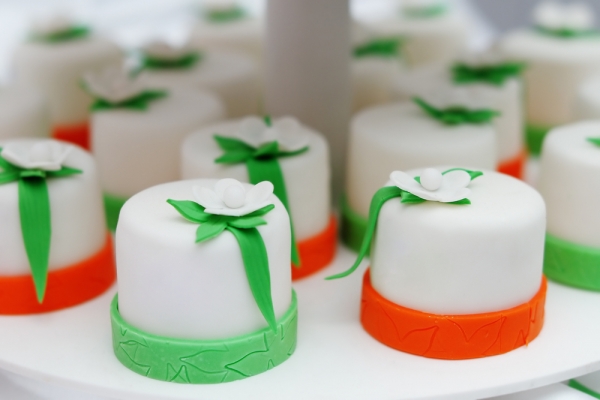
These properties are inherent even in ordinary dough made from wheat flour: after all, the dough also dries out, maintaining a certain shape, if left in the air. If wheat flour is boiled, it turns into a sticky mass. But this ingredient is not quite suitable in terms of taste for sugar paste. Therefore, professionals introduced sugar flour, that is, powder, into the composition of the confectionery mastic as the main ingredient.
Carbohydrates make up almost 100% of the mass of sugar. They, although they have binding properties, do not have the flexibility inherent in flour due to the lack of protein, unlike flour. Flour contains approximately 70% carbohydrates, but the remaining 30% contains moisture and fats, as well as proteins that can absorb and retain moisture. That is, this small amount of proteins is enough to create the necessary plasticity. But the fats contained in flour will significantly make the mastic heavier. Therefore, another component is needed, with a lighter structure. Starch does not contain fat, has both a loose structure and binding properties, so adding it to powdered sugar creates the desired consistency of sugar mastic for a cake at home.
Confectionery mastic in industrial conditions is created on the basis of collagen contained in gelatin. Thanks to the use of industrial technology, a higher quality paste is obtained. Gelatin does not contain fat, and the high content of animal protein allows it to bind crystalline sugar carbohydrates to obtain a plastic paste.
Sugar mastic can have different densities, taking into account its purpose. So, by adding more water, you can get a consistency that is thin enough to cover the surface of the cake using the pouring method. Making figures, flowers, lace from sugar mastic for a cake at home requires a thick sugar dough so that it retains the desired shape.
In a word, in order to quickly and easily learn how to work with mastic, you need to know its biochemical composition and physical properties.
This will help not only to successfully cope with confectionery mastic, purchased in specialized stores, but also prepare the desired pasta yourself.
Adding acid to mastic not only adds flavor to the confectionery product. Lemon juice or acid crystals diluted in water slow down the drying of the mastic and give additional time to create the decoration before the mastic dries.
Sugar flowers are flavored with different flavors using additives. For this purpose, it is possible to use fruit syrups, but then the amount of added water must be reduced, taking into account the moisture contained in the syrup.
Another important nuance: often in sugar mastic recipes there are such ingredients as glycerol And glucose. Please note that these components are only sold in specialized stores. Although they have a similar name to the components used in the manufacture of confectionery products, their composition is somewhat different from glucose for injection and glycerin for external use, sold in pharmacies.
On food coloring quality, helping to create culinary masterpieces should also be paid attention to. When purchasing colorful powders, make sure they are edible. Otherwise, it is better to use improvised natural paints contained in common products. Here are some examples:
Orange can be obtained from carrot juice;
Yellow– when adding turmeric powder and Indian saffron to sugar mastic for a cake at home;
Raspberry, any shades of pink– from beet juice;
Red– from the juice of cranberries, pomegranates, strawberries, raspberries, cherries; If you add a little lemon juice to cherry juice, you get a blue color;
Blue can also be obtained from the juice of red cabbage, blueberries, red grapes;
To receive green it is necessary to squeeze the juice from spinach leaves (it has a neutral taste, without aromatic oils);
Brown for mastic can be obtained by mixing powdered sugar with cocoa powder or adding melted dark chocolate to the mastic.
Other colors and shades can be obtained by combining the listed food colorings. Remember that orange and red fruits contain a fat-soluble vitamin, β-carotene, so to obtain the rich color, juice from the fruits must be extracted using a small amount of vegetable or animal fat. You can get the desired color by infusing the listed products in alcohol, followed by evaporation.
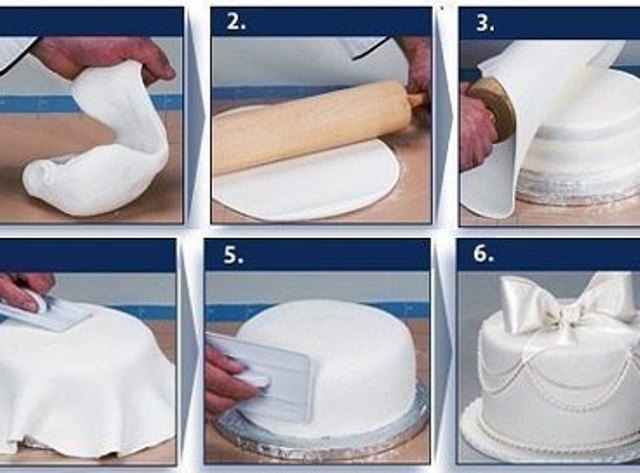
Now you can get sugar mastic for a cake at home in any color and realize your most daring and sophisticated ideas for decorating your own culinary masterpiece. All that remains is to prepare the mastic by choosing an acceptable recipe:
Milk-based sugar mastic
Ingredients:
Fine powdered sugar 120 g
Dry cream of any fat content 160 g
Corn starch 80 g
Condensed milk 8.5% 110 g
Glycerin (special) 50 ml
Vanilla or fruit flavor, alcohol
Citric acid 5 g
Water for acidic solution 20 ml
Preparation:
When using dry milk concentrates, you can use products with any fat content, since the dry substance when mixing sugar mastic for a cake at home will not have time to transform the fats it contains and transfer it to the dough. Fats will begin to work as soon as the product is consumed, participating in the creation of taste and in the digestion process.
Dilute citric acid in water. You can use lemon juice instead. Combine all dry mastic ingredients.
If mastic of different colors is needed, then the dyes can be dissolved in an acidic solution, dividing it into the required number of colors. In this case, it would be appropriate to replace the water for the citric acid solution, for example, with beet juice, which will produce a bright pink or raspberry colored mastic.
To achieve pale pink shades, combine beet juice with water to reduce the concentration of food coloring, but do not reduce the acid content, otherwise the mastic will dry out very quickly, which will prevent you from working with it to create decorations.
Be sure to sift the powder so that the mastic turns out very plastic and the sugar crystals do not break the structure. Add the dry mixture to the condensed milk, first stirring vigorously with a silicone spatula, then transfer the dough to a silicone surface and continue kneading with your hands.
When making jewelry, take the required amount of mastic and cover the rest with film so that it does not weather or dry out.
It is also better to roll out the mastic in a thin layer using silicone rolling pins of different thicknesses. If necessary, dust the working surface with powder. To add gloss, finished mastic products are brushed with a brush dipped in syrup with the addition of glycerin.
Sugar mastic on a gelatin basis
Ingredients:
Powder 600 g
Lemon juice 30 ml
Starch, corn 50 g
Gelatin 20 g
Glycerin 1 tbsp. l.
Water 200 ml (for jelly and to dissolve gelatin)
Vanilla 2-3 g
Glucose 10 ml
Preparation:
Brew starch in water. When it has cooled to room temperature, add glycerin and glucose to the resulting jelly. Dissolve the gelatin separately in a water bath, without raising the heating temperature above 40ºϹ. Sift powdered sugar more than the required amount for preparing mastic, so that if necessary, use it for the desired consistency, sprinkle the surface of the work table on which you will knead the sugar dough. Knead the dough from the bulk of the powder by first pouring starch jelly into it, and then melted gelatin.
Add the liquid ingredients gradually, while working vigorously with a silicone spatula and mixing the entire mass. Continue kneading the mastic on the table or silicone mat until the mastic acquires the desired plasticity, uniformity and at the same time no longer sticks too much to your hands. Cover the finished mass with film and leave for a while so that all the ingredients react with each other.
If you need to get mastic of different colors, then divide the finished white mastic into parts, add the dissolved dye and continue kneading the dough until an even, uniform color is obtained. When sculpting flowers and shapes, use powdered sugar to roll out the layers, sprinkling the sugar dough.
During the sculpting process, all colors of mastic should be covered with film to prevent a dry crust from forming: take only the amount that is necessary to make a flower or figure, and immediately hide the rest under the film. Think in advance about how to arrange the necessary flowers and shapes for drying, prepare the necessary forms for them in order to fix the dough in the desired position.
Bulk sugar mastic
Ingredients:
Milk 200 ml
Water 200 l
Powder 800 g
Fragrance
Lemon juice 50 ml
Gelatin 40 g
Preparation:
The consistency of the finished mastic should be similar to thick sour cream. This mastic is designed to smoothly cover the surface of the cake when complex relief patterns are not required.
Pour powdered sugar into boiling milk and, having dissolved it while stirring, remove the milk syrup from the heat and cool it to 30-40ºϹ.
Dissolve the gelatin in water and, after straining it, pour it into the milk mass, beating both parts with a mixer at low speed. Add vanilla or the desired fragrance, dye if you need to give the coating a certain color and lemon juice.
When the finished mastic has cooled and thickened a little, pour it onto the surface of the cake, starting from the center: the mass should flow off the cake randomly. Place the cake on a stand with a side so that the mastic does not spread across the work surface and stain the refrigerator shelves.
The surface of the torus must be perfectly smooth. To prevent the mastic from sliding across its surface, it is advisable to make a layer of marzipan, or dust the top of the cake with starch, cocoa powder or powdered sugar, depending on what ingredients suit the product.
Also, before filling the cake with mastic, it is advisable to cool it well so that the mastic hardens faster. Carefully collect the remaining liquid mastic that escaped onto the dish when pouring. You can add powdered sugar to them, knead stiff sugar dough and make curly decorations for the cake: border, bow, lace. You need to glue the parts of the sugar figures to each other using a brush dipped in water.
Sugar protein mastic
Ingredients:
Squirrels 5 pcs.
Cognac or liqueur
Vanilla
Lemon juice 50 ml
Powder 1.0 kg
Gelatin 30 g
Water 100 ml
Glycerin 40 ml
Preparation:
Beat chilled egg whites until stable foam, gradually add sifted powder without stopping whisking. Add lemon juice to the protein mixture, add vanilla and cognac.
Having dissolved the gelatin, pour it hot into the whites, continuing to knead the dough. When the mass thickens, transfer it to a work surface sprinkled with powder and bring the mastic to the state of a stiff dough, cover with film and after a couple of hours the mastic is ready to work with it.
Sugar mastic honey-chocolate
Ingredients:
Dark chocolate 2 parts
Honey, flower 1 part
Preparation:
For chocolate cakes, or cakes covered with chocolate icing, this sugar fondant recipe is - a real find, allowing you to stylishly decorate a chocolate dessert.
Making chocolate honey spread is quite easy. The only drawback: chocolate-honey mastic must be prepared in advance, because for plasticity it must be kept for at least 24 hours in the refrigerator, in plastic packaging.
Melt the chocolate over a steamer and pour in the honey, stirring continuously, until you get a thick mass that will stick off the dishes. After cooling slightly, wrap the mastic in film.
Sugar mastic with marshmallow
An effective way to obtain the desired consistency of sugar mastic for a cake at home is using marshmallow candies. They are candies made from gelatin and corn syrup. In industrial conditions, these ingredients are whipped into a sponge, adding flavorings and food coloring. Adding these sweets to the composition of sugar mastic for a cake at home greatly simplifies the task of preparing sugar dough. If you want to get the maximum best result, then use these candies only as an additional ingredient for dough viscosity, in combination with gelatin mastic prepared according to recipe 2 described above.
Ingredients:
Marshmallow part 1
Gelatin mastic 2 parts
Preparation:
Mix the sugar dough as directed in the second recipe above. Melt the marshmallows over steam, but do not overheat. Grind the candies first so that they dissolve as quickly as possible. Do not use a microwave; it will dry out the marshmallows, making the dough difficult to work with. By steaming them and thereby moistening the mass, you will make your work easier when kneading the dough.
You just need to prepare the marshmallow mastic in advance, letting it rest at room temperature in an airtight container. Make sure that the candies you use are fresh and choose a white color so that the mastic does not turn out ugly, with a gray or brown tint.
Sugar mastic from marmalade
The marmalade contains a fruit base and agar-agar. Only the marmalade for mastic needs to be sorted by color to get a specific color of mastic.
Ingredients:
Powdered sugar 700 g
Marmalade 250 g
Water 50 ml (or lemon juice)
Preparation:
Prepare a water bath for marmalade. Cut it into small pieces, place it in a smaller container, fill it with water and steam it, stirring constantly with a silicone spatula. Bring the fruit mass to a temperature of 60-70ºϹ so that it acquires a gelatinous consistency.
Sift the powder, pour it in a heap onto the silicone surface and make a depression into which pour the melted marmalade in small portions and quickly knead the mastic. This mastic requires heat. When working with it, keep the mass sealed in film, next to a heat source.
Marmalade mastic can be used to prepare flowers. To tighten the surface of the cakes, add more water to the mixture and use the pouring method.
-Sugar mastic is a troublesome type of decoration. To make sure that the decoration from it will be successful, prepare both the mastic itself and the decorations from it in advance, before you start baking the cake.
-Sugar mass in a sealed package can be stored in the cold for up to two months, except for protein mastic. Finished jewelry should dry indoors in low humidity.
-To work with mastic, on the one hand, it is convenient to lubricate your hands and the mat with food glycerin, but on the other hand, the readiness of the sugar dough can be determined by how easily it comes off from your hands. Shortly before the consistency of the mastic becomes visually plastic, to check it, wash off the glycerin film from your hands and try the sugar mass with your hands without a protective coating to determine its readiness.
How to cover a sponge cake with this sugar-gelatin mastic:
First, the biscuit must be coated with cream, boiled condensed milk or jam to even out all the unevenness of the biscuit.
On the surface of the sponge cake prepared and primed with cream, boiled condensed milk or jam, the sugar mastic will lie evenly and smoothly, there will be no protrusions or irregularities.
After the surface of the biscuits is prepared, you need to measure the diameter of the workpiece to cover the cake.
The diameter should be no less than the diameter of the biscuit, plus double the height and another 5 centimeters for folds and irregularities. For example, if you have a cake with a diameter of 20 cm and a height of 5 cm, then to cover the sponge cake you need to roll out the mastic to a diameter of at least 35 cm = 20+2x5+5.
It is convenient to roll out confectionery sugar mastic on a table greased and sprinkled with powdered sugar, or even better between two sheets of plastic film; the mastic rolled out on plastic film is very easy to transfer to a sponge cake, this can be done directly together with the film, which then just needs to be separated from the mastic and Continue leveling the mastic on the surface of the biscuit.
The thickness of the rolled sugar mastic for covering the biscuit should be about 5 mm; after you apply it to the cake and level it, it will stretch to the required 2-3 mm.
If you roll out sugar mastic immediately to a thickness of 2-3 mm, it can easily tear when working with it.
If you don’t have professional tools, then buy plasticine in a box that comes with modeling tools. You also need, preferably, 2 irons for tightening the cake and a knife for cutting mastic, such as for cutting pizza, a food felt-tip pen, if you will make an inscription directly on the mastic.
Note! Any mastic - marshmallow, sugar-gelatin or milk - will perfectly replace marzipan at home. Just keep in mind that it is not always advisable to cover the entire cake with mastic - although mastic coatings are very beautiful, they are quite hard.
*****************
“Making mastic at home”
“Modeling a rose from mastic”
"Chocolate mastic"
“Sculpting a bear from mastic”



